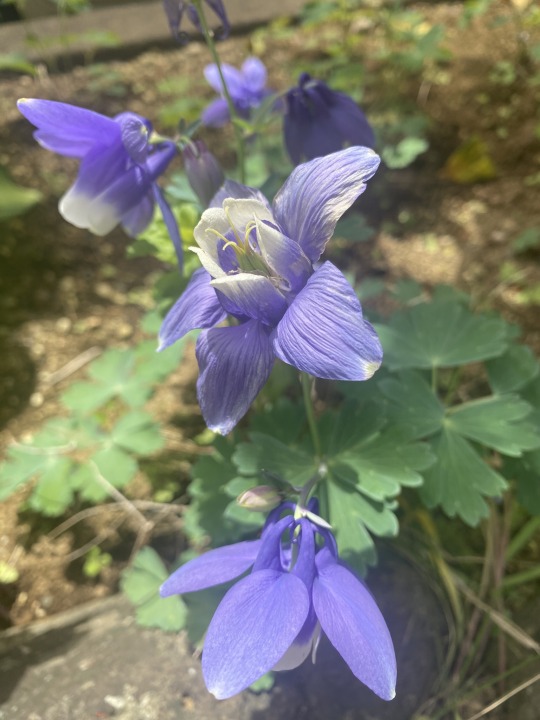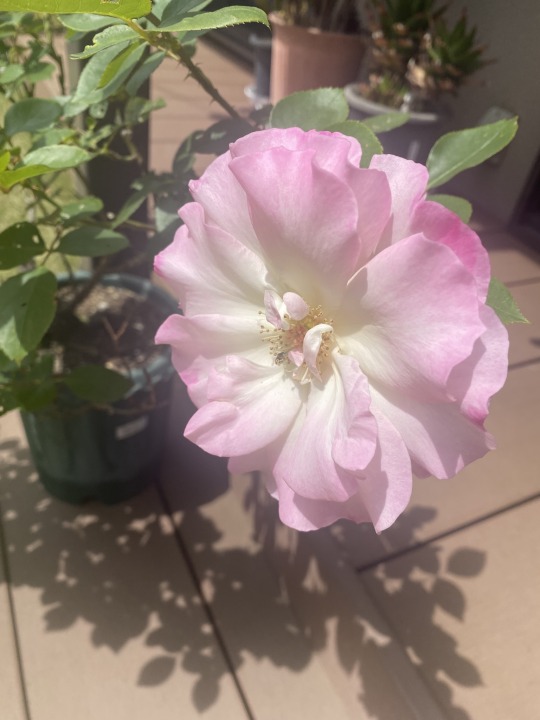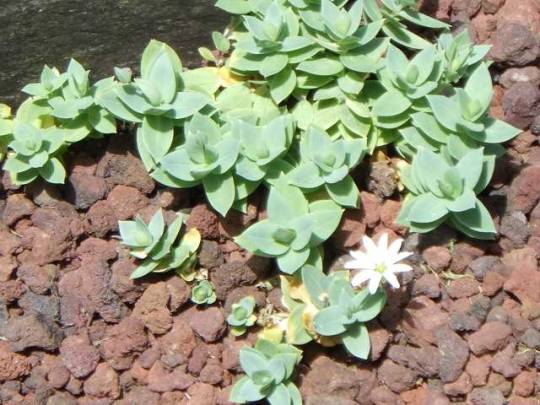#オダマキ
Explore tagged Tumblr posts
Text

Sent to CZECHIA on 18th of May 2024
0 notes
Text
Anime Sapphire!
#pokemon#indie anime#animation#pokespe#sapphire#sapphire birch#オダマキ・サファイア#pokemon adventures#pokemon manga#pokemon animation#I wish she had a real anime debut#or really anyone from pokespe because I love them all
476 notes
·
View notes
Text

職場に向かう途中の商店街にある
お花屋さんで咲いていた、
ピンク色の「アメリカ・オダマキ」の花。
オダマキ属。
別名:セイヨウオダナキ。
学名:Aquilegia vulgaris
撮影:iPhone14 Pro Max
104 notes
·
View notes
Text


ネロリ博士
優しい顔しているけど
博士だから
勿論野生のポケモンに
フィールドワークで傷付けられているし
睡眠の研究なので
無意識の行動で
他の博士より怪我が多かったら良いなと(オダマキ博士が一番多い)
あと毛深くて性欲強そうで
人たらしだとありがたい。
睡眠の質を見るのに添い寝してくれる。
59 notes
·
View notes
Text




mes possibilites aujourd'hui. 今日のわたしの可能性。 アッツ桜、ローズマリー、ビオラ・ラブラドリカの 植え替えをする。 ニゲラとオルレアの種を植える。 薄曇りの一日。 気温は思ったより高くなく、 半袖で過ごしたせいもあるのか 汗だくにならずに済んだ。 ムッキの月命日。 お花はようやく咲いた ポールセンのジジを。 時期的に花が少なくて、ちょっと淋しくてごめん。 これがいいなぁ、と思う おやつがなくて、 つくる時間も��くて、 今回は ムッキが大好きな甘栗をワープ。 こちらもちょっと淋しくてごめん。 午後は2時間半ほど庭作業。 鉢が割れたローズマリーの植え替え。 実生の苗がおおきく育っていて、驚く。 少し早いけど鉢上げしたかったので アッツ桜も植え替え。 ラブラドリカはオダマキと同居になるけど、 負けずに増えてほしいところ。 あとはアヤメの株分けが残っている。 バラたちもなんとか復活してきてくれた。 そろそろ庭だよりも書かなくちゃ。
4 notes
·
View notes
Text
1st Person Pronouns in Pocket Monsters Special
I thought it would be fun to have a look at what 1st person pronouns the Pokèdex Holders use in the Pokèmon manga, Pocket Monsters Special (known as Pokèmon Adventures in English).
Note: In Japanese, there are a ton of different 1st person pronouns people can use, and Japanese media often makes copious use of them. In a lot of shounen and shoujo manga/anime casts, you'll often get a large variety of 1st person pronouns in use by different characters to help flesh out their personality traits.
Note: I am not a native Japanese speaker, and I only have a conversational level in Japanese, as opposed to a fluent level. As such, please don't take anything I say as gospel.
* Red (レッド) ^ Fighter (戦う者): ore (オレ)
* Green Orchid (オーキド・グリーン) ^ Trainer (育てる者): ore (オレ)
* Blue (ブルー) ^ Evolver (化える者): atashi (アタシ)
* Yellow de Tokiwa Grove (イエロー・デ・トキワグローブ) ^ Healer (癒やす者): boku (ボク)
* Gold (ゴールド) ^ Hatcher (孵す者): ore (オレ)
* Silver (シルバー) ^ Exchanger (換える者): ore (オレ)
* Crystal "Crys" (クリスタル 「クリス」) ^ Catcher (捕える者): watashi (わたし)
* Ruby (ルビー) ^ Charmer (魅せる者): boku (ボク)
* Sapphire Odamaki (オダマキ・サファイア) ^ Conqueror (究める者): atashi (あ���し)
* Emerald "Rald" (エメラルド「ラルド」) ^ Calmer (鎮める者): ore (オレ)
* Diamond "Dia" (ダイヤモンド 「ダイヤ」) ^ Empathizer (感じる者): oira (オイラ)
* Pearl (パール) ^ Determiner (志す者): ore (オレ)
* Platinum Berlitz (プラチナ・ベルリッツ) ^ Understander (知る者): watashi (私)
* Black (ブラック) ^ Dreamer (夢みる者): ore (オレ)
* White (ホワイト) ^ Dreamer (夢みる者): atashi (アタシ)
* Lack-Two (ラクツ) ^ Arrester (逮捕る者): boku (ボク)
* Whi-Two (ファイツ) ^ Liberator (解放す者): atashi (あたし)
* X (X) ^ Loner (籠る者): ore (オレ)
* Y na Gabena (Y・ナ・ガーベナ) ^ Flyer (翔ぶ者): atashi (アタシ)
* Sun (サン) ^ Saver (貯める者): orecchi (オレっち)
* Moon (ムーン) ^ Mixer (調合る者): watashi (わたし)
* Sword Tsurugi (剣創人) ^ ???: boku (ボク)
* Shieldmiria Tate (盾シルドミリア) ^ ???: atashi (あたし)
Here's a rough outline of what all these pronouns indicate:
* watashi (私): 私 watashi is one of the more formal ways to refer to oneself in the 1st person. The fact that it's written in kanji and not in hiragana or katakana increases the politeness. When it's used by women, it can be perceived as casual as well, but it's usually only used by men in formal situations.
* watashi (わたし): わたし watashi is slightly less formal than 私 watashi, due to the fact that わたし watashi is written in hiragana. It's a safe way for a woman to refer to herself in both formal and casual situations. It can be used by men in formal settings, but it comes off as somewhat stiff if men use it in casual settings. When spelled in katakana (ワタシ), it can perceived as quite rough.
* atashi (あたし): あたし atashi is a less formal, more feminine version of わたし watashi. It has a "girly" and "cutesy" tone to it. The fact that it's spelled in hiragana makes it a pretty neutral 1st person pronoun for girls.
* atashi (アタシ): アタシ atashi is a rougher version of あたし atashi , due to it being spelled in katakana. It's one of the most informal 1st person pronouns a girl can use, though it still has the same "girly" and "cutesy" tone to it as its hiragana counterpart.
* boku (ボク): ボク boku is usually used by boys but can be used by girls, particularly tomboys. When spelled in kanji (僕) or hiragana (ぼく), it can be a formal way for boys to speak, but when spelled in katakana (ボク), and when used by girls, it's pretty informal.
* ore (オレ): オレ ore is a very rough, "boyish" way to refer to oneself in the 1st person. It's rarely used by girls. It can occasionally be spelled in kanji (俺) or hiragana (おれ), but the katakana spelling (オレ) is usually preferred, because it helps emphasise the roughness of the pronoun.
* orecchi (オレっち): オレっち orecchi is a slightly less rough version of オレ ore. In this case, its first half, オレ ore, is spelled in katakana, while its second half, っち cchi, is spelled in hiragana. This pronoun is usually used by boys who want to appear tough but not quite as tough as boys who use オレ ore.
* oira (オイラ): オイラ oira is similar to オレ ore and オレっち orecchi, but it has a more "friendly" and "country bumpkin" feel to it. It's usually used by boys who want to appear tough but don't want to use オレ ore. One could consider オイラ oira to be a cross "between" ボク boku and オレ ore: more gentle than オレ ore, but more rough than ボク boku.
And, just for fun, here's a list of the many other kinds of 1st person pronouns that I've come across in various Japanese media:
* watakushi (私): 私 watakushi is one of the most polite ways of referring to oneself in the 1st person. It can be used by anyone in formal settings. It's almost always spelled in kanji (私) and rarely in hiragana (わたくし) or katakana (ワタクシ).
* atakushi (あたくし)/atakushi (アタクシ): あたくし atakushi is probably between わたし watashi and あたし atashi in terms of formality. It's often used in fiction by princess-like characters or high-born ladies. It can have a somewhat superior and "snooty" tone to it.
* atai (あたい)/atai (アタイ): あたい atai is a very rough corruption of あたし atashi, usually used by girls. It can almost be thought of as the feminine equivalent of オレ ore, as both are usually only used by people who want to sound tough or aggressive. It's usually written in katakana (���タイ).
* watasha (わたしゃ)/watasha (ワタシャ): わたしゃ watasha is a bit of a "country bumpkin" version of わたし watashi. It's gender-neutral but is usually used by girls. It can be perceived as semantically plural due to the しゃ sha, which is used to make some formal pronouns plural, like 我が waga becoming 我が社 waga-sha. It can carry a single meaning notionally, however.
* atasha (あたしゃ)/watasha (アタシャ): あたしゃ atasha is the feminine equivalent to わたしゃ watasha. Like わたしゃ watasha, あたしゃ atasha has a bit of a "country bumpkin" feel to it. Also like わたしゃ watasha, あたしゃ atasha can carry a plural meaning due to its しゃ sha, though it can still be used in a singular context as well.
* wate (わて)/wate (ワテ): わて wate is a somewhat dated Kansai dialect pronoun. It's informal and gender-neutral, and can still be seen in some, usually older, forms of Japanese media.
* ate (あて)/ate (アテ): あて ate is the feminine equivalent of わて wate. Like わて wate, it's an informal Kansei dialect pronoun, and also like わて wate, あて ate somewhat dated. It shows up in some forms of Japanese media, particularly older ones.
* wai (わい)/wai (ワイ): わい wai is another Kansai dialect pronoun, possibly a severely corrupted form of わたし watashi. It's informal and usually used by boys. Amusingly, it's also a homophone of the Japanese word for yay or yippee, ワイ wai.
* ware (我): 我 ware is a very formal 1st person pronoun that is almost "literary-style" and is usually used in writing. It can be made plural by adding 々 ware.
* waga (我が): 我が waga is an extremely formal, gender-neutral pronoun that literally means my. It can be made plural by adding 社 -sha.
* ore-sama (オレ様): オレ様 ore-sama is usually only used sarcastically or by fictional characters who are extremely arrogant. It can be accurately translated as my esteemed self. It's almost exclusively used by boys.
* jibun (自分): 自分 jibun is a neutral, semi-formal pronoun that can be used by anyone. It's also the reflexive (-self/-selves) form of all pronouns in Japanese. This is actually a very good choice for a 1st person pronoun if you're non-binary and don't want to gender yourself.
* uchi (内): 内 uchi literally means house. It has two uses. Firstly, it can be used as a gender-neutral, somewhat formal way of referring to oneself and members of one's own's group, as in our family, our class, etc. Secondly, 内 uchi is used in western dialects, particularly the Kansai dialect, usually by girls, to indicate a "girly" and "cutesy" tone. In the second case, it's usually written in hiragana (うち) or katakana (ウチ).
* ora (おら)/ora (オラ): おら ora is a corruption of オイラ oira. Like オイラ oira, it has a bit of a "country bumpkin" tone to it and is usually used by boys. It's considered rougher than オイラ oira. It's usually written in katakana (オラ).
* me (me)/mii (ミー): me, or ミー mii, is from the oblique case of the 1st person pronoun in English, me, though it's used for all cases when applied in Japanese. It's often used by, usually male, characters in Japanese media who are meant to be from America or some other English-speaking country. It's quite rough and informal.
That's all for now. Thanks for reading. :)
Note: If you enjoyed this post, you might also enjoy my post on gender-neutral 3rd person pronouns in Japanese.
#ポケットモンスター SPECIAL#pocket monsters special#pokemon adventures#japanese language#日本��#pronouns#代名詞#my writing
9 notes
·
View notes
Text
Today's Haiku with Picture 602

Aquilegia
Probably poisonous
Characteristic
オダマキの
毒はありそう
個性的
(2023.04.24)
3 notes
·
View notes
Text










おはようございます(^^)/
先日、コロナ後、初!実家に行った時の庭です。いろいろ咲いていました。
1、2→モッコウバラ
3→オダマキ
4、6→バラ(何バラかは分からず^^;)
5→シャクナゲ
7→?
8→スズラン
9→ヒメウツギ
10→?
分からないところ、分かる方いらっしゃったら教えてください。
2 notes
·
View notes
Text

❤TRPGで使用したPCの絵
ステラナイツの白オダマキでした❕

1 note
·
View note
Text
悪趣味っちゃ悪趣味だけど、それよりも納得の方が大きかったよ。だから君はいつもああいう結果に行き着いてたんだな、って。愚かで哀れで、どうやって生きてきたらそんなにうぬぼれられるんでしょう。そりゃあ報われるはずもないよね。過去のお相手様方同ご愁傷様です。で、バレてんのにいつまでその面見せてくんの?嫌がらせが趣味なのか、奪い愛に背徳感を感じる癖なのか。あ、それってバレた後の行動決めてるんですかね。いつまでイイ顔してもらえると思ってるんだか。アタマの中でお花屋さんでも開きます?ふふ。それなら、オダマキと、それからシラー、スイセンを花束にして頂けますか?貴方にそのまま贈りたくて。
0 notes
Text
0 notes













